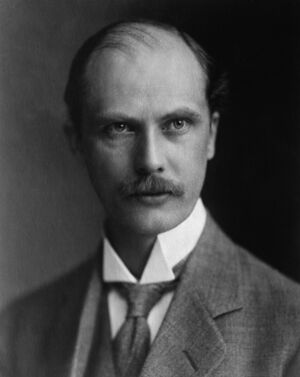Rickard Sandler
( politician) | ||||||||||||
|---|---|---|---|---|---|---|---|---|---|---|---|---|
 | ||||||||||||
| Born | 29 January 1884 Torsåker, Västernorrland County | |||||||||||
| Died | 12 November 1964 (Age 80) Stockholm, Stockholm County | |||||||||||
| Nationality | Swedish | |||||||||||
| Alma mater | Uppsala University | |||||||||||
| Parents | Johan Sandler | |||||||||||
| Spouse | Maria Lindberg | |||||||||||
| Party | Swedish Social Democratic Party | |||||||||||
Prime Minister of Sweden in the 1920s. Swedish Minister for Foreign Affairs in the 1930s, then leader of the parliamentary Committee for Foreign Affairs until his death in 1964. Attended the 4th Bilderberg
| ||||||||||||
Rickard Johannes Sandler was a Swedish politician and Prime Minister of Sweden in the 1920s. He was Leader of the Committee for Foreign Affairs 1940-1964, when he attended the 1956 Bilderberg meeting.
Background
Rickard was son of the teacher and later liberal parliament member Johan Sandler.[1]
Eduction
He initially completed a teacher training course at Uppsala University. After that, from 1905 to 1926, he was, among other things, a teacher at the school of Kramfors, where his father was rector. In 1911 he also took a degree in Philosophy from the University of Gothenburg.[1]
Political career
Sandler began his political career in 1911 with the election as a member of the Board of the Swedish Social Democratic Party (SAP), to which he belonged until 1952. In 1912 he was one of the co-founders of Arbetarnas Bildningsförbund, the education department of the Swedish Labour Movement. In 1917 he also became the editor of Ny Tid, the daily newspaper of party published in Gothenburg. In these functions, he was also one of the main authors of the Marxist-influenced party program of the party in 1920.[1]
Already in 1918 he was appointed state secretary of the Minister of Finance Fredrik Thorsson in the cabinet of Nils Edén. He also took over this office on 10 March 1920 in the cabinet of Karl Hjalmar Branting. In this capacity, he was also acting Minister of Finance from July to October 1920, when Thorsson became Minister of Trade.
Branting also appointed him Minister without portfolio in his second government from 13 October 1921 to 19 April 1923. He was also Minister of Trade in the third cabinet of Branting from October 18, 1924 to January 24, 1925.
When Branting resigned for health reasons a few weeks before his death on January 24, 1925 and the intended successor candidate Fredrik Thorsson also fell seriously ill, Sandler was appointed Prime Minister of Sweden by King Gustav V at the age of only 41.[1]
As Prime Minister, he was responsible in particular for carrying out the reduction of the army promised by the Social Democratic Party during the election campaign. In particular, he was supported by the Liberal Party.[1]
Another important decision of his government was the cancellation of a decision of the Unemployment Commission, which refused to continue paying the striking workers of the Stripa mine. This led to a government crisis, as the liberal and conservative majority of Parliament rejected the government's decision. The resulting vote of no confidence led to Sandler's resignation as Prime Minister on 6 June 1926 and the succession by Carl Gustaf Ekman.
He then became director of the Central Statistical Office, Statistiska centralbyrån (SCB) from 1926 to 1932.[1]
After retiring from government politics for several years, he was appointed Foreign Minister in the first cabinet of Prime Minister Per Albin Hansson on September 26, 1932. Apart from a brief interruption during the government of Axel Pehrsson-Bramstorp from 19 June to 28 September 1936, he also held this office in the second Hansson cabinet until 13 December 1939.[1]
On December 13, 1939, he resigned as Foreign Minister due to a disagreement with Prime Minister Hansson over the Winter War between Finland and the Soviet Union. Sandler demanded an active support of Finland, but this was rejected by the Prime Minister.
He remained an influential foreign politician of his country. In the 1940 election he was elected a member of parliament. From 1940 he was a member of the Committee for Foreign Affairs (Utrikesutskottet), from 1946 until his death in 1964 even as its chairman.[1]
He was also a member of the Swedish delegation to the United Nations (UN) from 1947 to 1960. Other offices
In addition, Sandler was also the regional president (Landshövding) of the province of Gävleborg from 1941 to 1950.
In addition, he was repeatedly appointed chairman of various government commissions: for example, he was chairman of the socialization commission from 1920 to 1936. After the Second World War, from 1945 to 1947 he was chairman of the so-called Sandler Commission, which coordinated the post-war Swedish refugee an intelligence agency policy[2]. Finally, he was appointed chairman of the Constitutional Commission from 1954 to 1963.
Event Participated in
| Event | Start | End | Location(s) | Description |
|---|---|---|---|---|
| Bilderberg/1956 | 11 May 1956 | 13 May 1956 | Denmark Fredensborg | The 4th Bilderberg meeting, with 147 guests, in contrast to the generally smaller meetings of the 1950s. Has two Bilderberg meetings in the years before and after |